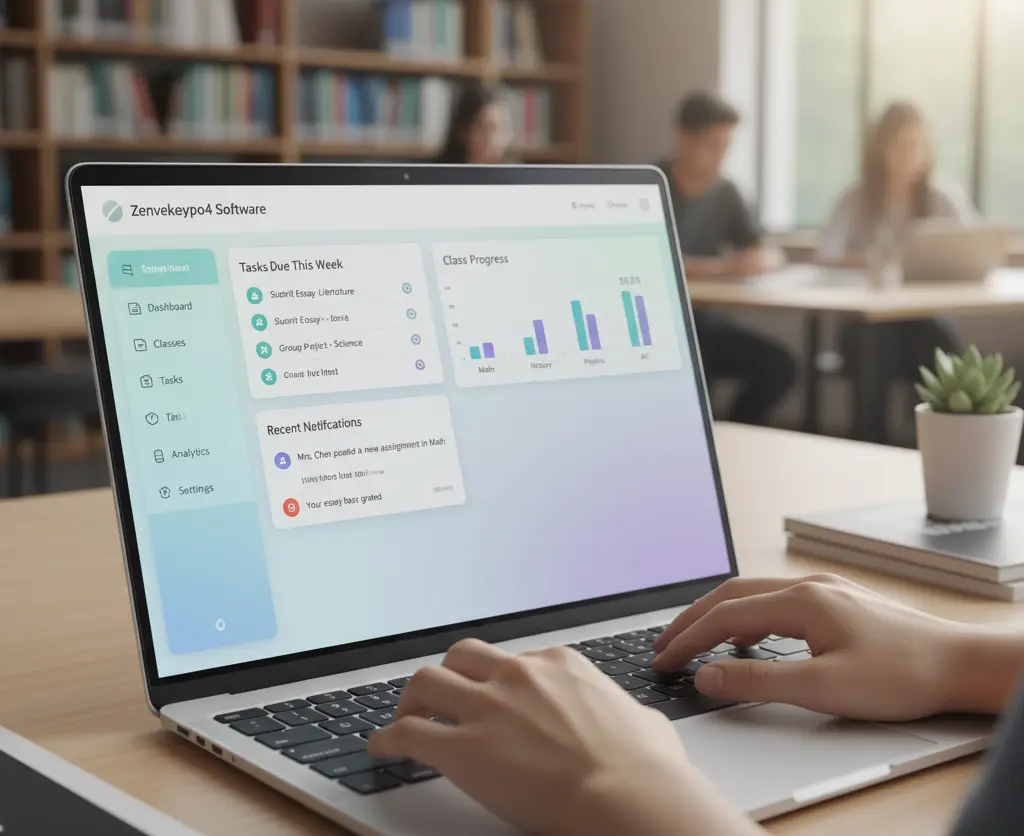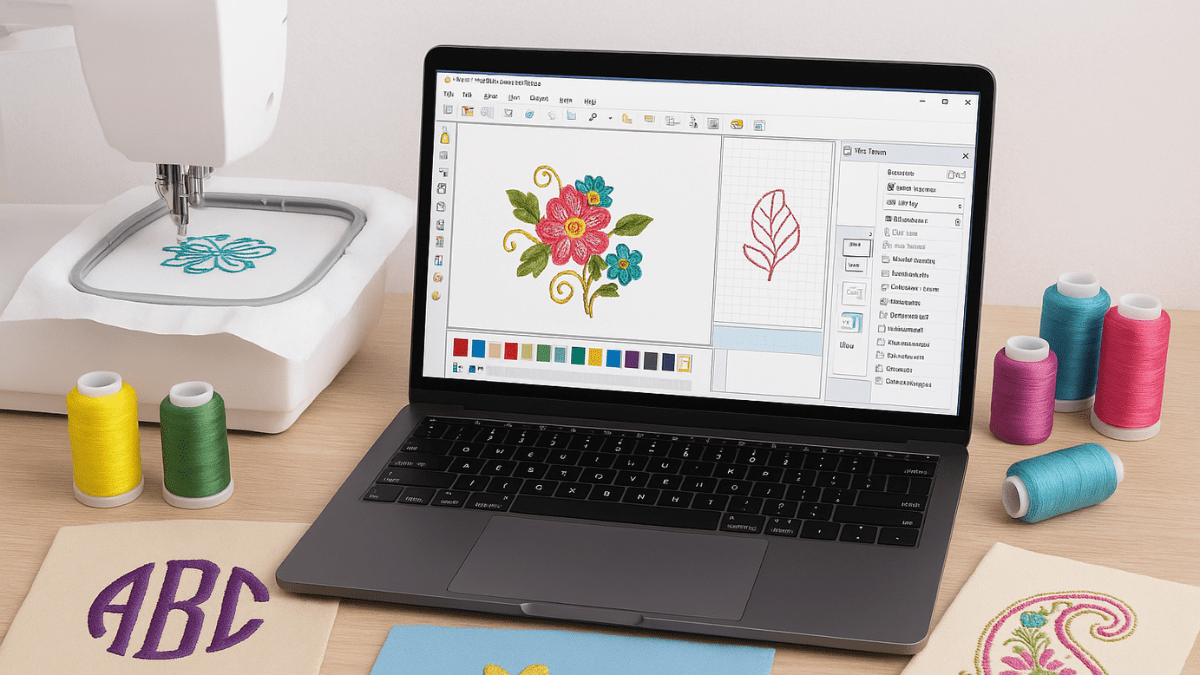Tech
Zenvekeypo4 2025: The AI-Powered Productivity Suite Changing How Teams Work

Imagine an application that brings your tasks, classes, school projects, and team workflows into a single smart space. A platform where teachers can share assignments, students can track progress, and IT pros can integrate and automate workflows—all without juggling half a dozen tools. That’s what Zenvekeypo4 Software promises to deliver. By 2025 it’s increasingly being adopted by educators, administrators and professionals looking for a streamlined productivity and learning-management solution.
Whether you’re a student logging in for the first time, a teacher deploying a class workflow, or an IT specialist evaluating tools for your institution, this guide walks you through everything: what Zenvekeypo4 is, how it works, how to use it, how it stands out, and what to watch out for.
What Is Zenvekeypo4 Software?
Zenvekeypo4 Software is a modern productivity and workflow-management platform designed to unify task-management, collaboration, automation and analytics in one environment.
- For students: It’s a dashboard where you can track assignments, upload work, collaborate with classmates, and monitor your progress.
- For teachers: It serves as a class portal: course creation, assignment distribution, grade tracking and student analytics.
- For IT professionals/admins: It offers integration with existing systems (cloud or on-premise), user-management, data security and analytics.
The vision: bring together the pieces that normally live in separate apps (classroom LMS, project-tracker, automation tool, analytics) into one flexible, adaptable platform.
Understanding the Concept Behind Zenvekeypo4 Software
Why does this matter now? Schools, universities and companies alike face a fragmented digital ecosystem: many separate applications, multiple logins, disconnected workflows, and heavy switching cost. Zenvekeypo4 is built to address that.
- It aims to reduce tool-fatigue.
- It provides a unified interface for learners, educators and administrators.
- It supports automation: repetitive tasks can be handled behind the scenes, freeing up time for actual teaching, learning or managing.
- Emerging requirements (hybrid learning, remote teams, blended workflows) demand systems that work both for “beginner users” and “power users/IT admins.” Zenvekeypo4 aims to bridge this gap.
In short: it’s not just another LMS or “task app”—it’s designed to be a full-ecosystem workflow platform.
Key Features of Zenvekeypo4 Software
Let’s break down the major tools you’ll find and why they matter for different users (students, teachers, IT pros). Many of these features are supported across several sources.
1. User-Friendly Interface
The UI is designed to be approachable. Whether you’re a student opening the tool for the first time, or a teacher assigning homework, the interface aims to be clean, well-organized and intuitive.
2. Task & Project Management
You can create tasks, subtasks, set deadlines, assign ownership (student → teacher → group), track status, and visualize progress. Especially helpful for educators managing multiple classes.
3. Automation and Shortcuts
Automation engines let you define triggers (e.g., “When student uploads assignment, notify teacher”, “When grade posted, alert student/parent”). Also shortcuts and custom workflows reduce repetitive work.
4. Collaboration and Communication
Work together on tasks, share files, chat within the platform. For a classroom or project team, this means less switching between email, chat apps and file-folders.
5. Analytics, Tracking & Reporting
For teachers and administrators especially: dashboards that show who submitted what, how students are performing, trends over time. Enables proactive intervention rather than reactive.
6. Integration & Extensibility
Works with other platforms (Google Workspace, Microsoft 365, cloud services) and supports API/webhook integrations so existing systems can be leveraged.
7. Security & Performance
Encryption, role-based access, compatibility across devices (desktop, web, mobile). The software emphasizes being lightweight so that even older hardware can run it.
Why Zenvekeypo4 Software Is Changing How We Learn and Work
These are the reasons the platform is getting traction, especially in educational and hybrid-working environments:
- It supports one-stop workflows (students: login → tasks → submission → results; teachers: course → assign → grade → analytics).
- Real-time visibility: instead of waiting for a report card or end-of-week progress meeting, students, parents (if applicable) and teachers can see updates continuously.
- Automation frees time: teachers spend less time managing logistics, students less time lost chasing resources or deadlines.
- Flexibility: works across devices, supports both individual and group work, supports blended/hybrid models (in-person + online).
- Data-driven decisions: administrators and educators can spot patterns (e.g., students falling behind) earlier and intervene.
In short, Zenvekeypo4 helps shift from “managing the tool” to “managing the learning/work”.
Difference Between Zenvekeypo4 Software and Traditional Platforms
If you’re familiar with standard LMS tools (like Moodle or Blackboard) or typical project-management apps (like Trello or Asana), here’s how Zenvekeypo4 stands out:
| Feature | Traditional LMS / Task App | Zenvekeypo4 Software |
| Focus | One domain (e.g., classroom or project tasks) | Unified: education + team productivity + automation |
| Customisation / Automation | Often limited or requires add-ons or scripting | Built-in automation, shortcuts and workflows |
| Analytics & Insights | Basic gradebook or task status | Real-time dashboards, trend tracking, proactive alerts |
| Integration | Separate tools for school, collaboration, tasks | Single platform integrates workflows, tools and systems |
| Technical Overhead | May require heavy setup or training | Designed for both beginners and advanced users |
This is not to say “traditional tools are bad”—they serve many well. But for environments where multiple roles (student, teacher, IT) overlap and where flexibility and speed matter, Zenvekeypo4 offers a more modern approach.
How to Use Zenvekeypo4 Software — Step-by-Step Guide
Whether you’re a student, teacher or IT professional, here’s a breakdown of how to get started.

1. Logging In / Initial Setup
- Visit the official site (or app) and download or open offline version as required.
- Create your account (or your institution’s IT admin does).
- Verify your email and set password; enable multi-factor authentication if available (recommended).
- For first-time users: choose your role (student, teacher, admin).
2. Setting Up Your Profile and Dashboard
- Upload a profile picture (optional).
- Choose notification preferences: e.g., “Notify me when new assignment posted”, “Notify parent when grade updated”.
- Organize your dashboard: drag and drop widgets you want to see first (tasks due, recent grades, upcoming class).
- Teachers: upload class list or sync with your institution’s student information system (SIS).
3. Joining or Creating a Course/Class (Teacher & Student)
- Students: Click “Join Class” and enter the access code provided by your teacher; the course appears in your dashboard.
- Teachers: Click “Create Course/Class”, enter title, description, select visibility, set start/end dates, upload syllabus, and distribute access code.
- Add modules/resources: videos, PDFs, links, assignment templates.
4. Submitting Assignments & Accessing Materials (Student)
- Navigate to the “Materials” or “Resources” tab in your class.
- Locate the assignment: read instructions carefully, check due date/time.
- Attach your file (or type directly if allowed).
- Click “Submit”. Confirm submission message appears. You may revise before deadline if your instructor allows.
- After grading, you’ll see feedback and score in the “Grades” section.
5. For Teachers: Creating Assignments and Grading
- In your class, select “Add Assignment”. Fill in title, description, due date, attach resources.
- Choose grading method: points, rubric, letter grade, pass/fail.
- Publish the assignment; students get notifications.
- After submissions, go to “Gradebook”: mark submissions, leave comments, input scores. Analytics dashboard shows submission rates, late work, grade distribution.
6. Monitoring Progress & Analytics (Admin/Teachers)
- Open the analytics panel: view submission rates by class or student, identify students who haven’t submitted, track trends over time.
- Generate reports for parents or administrators: export to CSV, PDF or share online link.
- Use alerts to notify when any student falls below a threshold or when assignments are not submitted on time.
Using Zenvekeypo4 Software for Students
This section is tailored for students — what you’ll benefit from, and how to make it work.

Benefits for Students
- All class materials, tasks and deadlines located in one place — no more hunting for emails or lost links.
- Real-time grade/feedback visibility means fewer surprises at report time.
- Collaboration tools let you work with classmates without leaving the platform.
- Mobile access means you can review or submit from anywhere.
- The automation (e.g., notifications) helps you stay on track.
Student Success Tips
- Log in daily: check your “Due Soon” list, upcoming tasks, notifications.
- Organize your dashboard: prioritise tasks by deadline or subject.
- Use the “Materials” section to review class resources ahead of time.
- For group work: create a shared project space within Zenvekeypo4, assign tasks to each teammate, set internal deadlines.
- Review feedback: after each graded assignment, read comments carefully to improve.
- Explore mobile app or offline mode (if supported) to leverage downtime (commute, waiting rooms, etc.).
Using Zenvekeypo4 Software for Teachers
Teachers face multiple demands — lesson planning, grading, student communications, parent updates. Zenvekeypo4 helps lighten the load.

Key Teacher-Features
- Build courses quickly: duplicate previous year’s course, reuse resources, adjust context.
- Auto-grading (for objective questions) and integrated gradebook.
- Discussion boards for asynchronous student engagement.
- Analytics dashboard to identify at-risk students early.
- Parent/guardian access (if enabled) to boost transparency and reduce repeat inquiries.
Teacher Time-Savings Table
| Feature | What It Does | Typical Time Saved Weekly* |
| Course duplication/template | Reuse existing course structure | 2-3 hours |
| Auto-grading of quizzes | Instant scoring for objective questions | 1-2 hours |
| Discussion board monitoring | Student forums replace repeated in-class Q&A | 1-1.5 hours |
| Analytics & early alerts | Spot issues before they become crises | 1-2 hours |
| * Estimates will vary by class size and system use. |
Best Practices for Teachers
- At start of semester: set up course, upload syllabus, modules, and enable student notifications.
- Define clear due dates, instructions, and submission formats to avoid confusion.
- Encourage students to use the “Materials” section rather than emailing you for resources.
- Use the analytics panel weekly to spot students missing submissions or lagging grades and reach out early.
- Maintain a shared discussion board: pose questions, encourage peer responses, monitor participation.
- Integrate with existing tools (Google Drive, Microsoft OneDrive) to avoid duplicating work.
Using Zenvekeypo4 Software for IT Professionals / Administrators
From an IT and institutional perspective, adopting a new platform involves provisioning, integration, security, training, and maintenance.
Key Admin & IT Features
- User management: roles (student, teacher, parent, admin) with appropriate permissions.
- Integration with student information systems (SIS) and single-sign-on (SSO) for smooth access.
- Data security: role-based access control (RBAC), encryption, backups, compliance with privacy standards.
- Scalability: platform works on various OS (Windows, macOS, Linux), and supports on-premises or cloud deployment.
- Logging/analytics: track system usage, user adoption, errors, performance metrics.
Deployment & Maintenance Checklist
- Verify system requirements: ensure servers (or cloud instances) meet recommended specs (RAM, CPU, storage).
- Plan user roles and permissions: define who can create courses, who can grade, who can edit workflows.
- Set up integrations: SSO, calendar sync, Google/Microsoft, email notifications.
- Train users: students, teachers, parents. Provide quick start guides and troubleshooting tips.
- Monitor performance and data: regular backups, update schedules, security audits.
- Plan for growth: monitor usage growth, storage needs, and scale horizontally if required.
Benefits of Zenvekeypo4 Software
Here’s a summary of concrete benefits for all stakeholder groups:
- Unified platform: reduces need for multiple apps and tools.
- Time savings: automation and built-in workflows reduce manual tasks.
- Improved organisation and transparency: students, teachers and parents stay aligned.
- Enhanced collaboration: peers and teachers can engage seamlessly.
- Real-time feedback and tracking: early intervention and continuous visibility.
- Flexibility and scalability: from small class to whole institution deployment.
- Cost-effectiveness: fewer subscriptions, fewer tools to manage, fewer integration headaches.
Common Problems & Quick Fixes
No software is perfect. Here are some issues reported by users of Zenvekeypo4, and how you can handle them.
Issue: Installation or Launch Fails
Cause: System doesn’t meet requirements, antivirus blocking installer, incomplete download.
Fix: Ensure the system meets minimum specs; disable antivirus temporarily; download from official/verified source; run installer as administrator.
Issue: Slow Performance or Freezing
Cause: Too many background apps, large data load, hardware limitations.
Fix: Close unnecessary apps; update system drivers; ensure adequate RAM and storage; reinstall if needed.
Issue: Course or Assignment Not Showing
Cause: Teacher hasn’t published the course; student didn’t join via correct access code.
Fix: Student: re-enter access code; Teacher: Publish course and verify dates/visibility; Admin: Check enrollment sync.
Issue: Analytics or Grades Not Updating
Cause: Delay in synchronization, version mismatch, caching issues.
Fix: Refresh dashboard; ensure the software is up to date; clear cache; check internet connection.
Best Practice Tips
- Always back up configuration settings.
- For teachers: send students a checklist of how to submit assignments to reduce confusion.
- For IT: monitor system logs weekly to detect any emerging issues.
Zenvekeypo4 Software vs. Other Platforms
Here’s a comparison of how Zenvekeypo4 stacks up against major competitors in 2025. This helps you understand where it fits.
| Platform | Ease of Use | Mobile Support | Analytics & Reporting | Integrations | Cost |
| Zenvekeypo4 Software | Excellent | Full featured | Advanced real-time | Extensive (cloud & legacy) | Mid-range |
| Google Classroom | Excellent | Good | Limited | Best for Google ecosystem | Free (for many) |
| Canvas LMS | Good | Good | Advanced | Extensive | Higher than mid- |
| Moodle | Moderate | Limited (depends) | Good but variable | Very high (open-source) | Free/Open-Source |
| Blackboard | Fair | Good | Advanced | Extensive but complex | Expensive |
Key Takeaways:
- If you are looking for simplicity and cost-effectiveness, Google Classroom wins but lacks advanced features.
- If you need enterprise-grade features and integration, Canvas or Blackboard are strong but come with higher cost and complexity.
- Zenvekeypo4 offers an appealing middle ground: deep features, good flexibility, and manageable complexity—especially for educational institutions and small-to-medium organizations.
The Future of Digital Learning & Work with Zenvekeypo4 Software
The world of education and productivity is evolving rapidly. Hybrid learning, remote work, AI-assisted workflows and data-driven insights are increasingly important. Zenvekeypo4 is positioned to ride these trends.
Trends to Watch
- AI-Powered Personalization: Platforms will increasingly adapt tasks, workflows and learning pathways based on user behavior and performance. Zenvekeypo4’s architecture suggests support for that.
- Edge & Cloud Hybrid Models: Some processing happens locally (for responsiveness), and some in the cloud (for scalability). Zenvekeypo4 supports these hybrid models.
- Deeper Analytics & Predictive Insights: Not just “who missed an assignment?” but “who is likely to need help next month?”.
- Seamless Mobile & Offline Workflows: Learning and tasks don’t stop just because the network is poor. Offline support becomes critical.
- Single Platform for Multi-Roles: The boundaries between student, teacher, admin, collaborators are blurring; tools must support all.
How Zenvekeypo4 is Leading
- It already offers flexible modules rather than rigid structures.
- It supports both beginners and advanced users (students and IT pros).
- It emphasizes integration, automation and real-time tracking—key traits of future-ready platforms.
Frequently Asked Questions (FAQ)
Q: Is Zenvekeypo4 Software free to use?
A: Yes — there is a free or “community” tier available for beginners or small teams. Premium/enterprise features (advanced analytics, large team integrations) may require a paid license.
Q: Can I access Zenvekeypo4 Software on mobile?
A: Yes. It supports web access, desktop (Windows/Mac) and has mobile versions (iOS/Android). Some features may require internet for full functionality.
Q: Is Zenvekeypo4 compatible with existing tools (Google, Microsoft, etc.)?
A: Yes. It supports integration with major productivity suites and offers APIs/web hooks for custom connections.
Q: Is Zenvekeypo4 secure for student data and institutional use?
A: Yes—it includes encryption, role-based access control, data backups, supports cloud/hybrid deployments and aims to meet institutional security requirements.
Q: What if we already use another LMS or workflow tool?
A: You can still adopt Zenvekeypo4; its integration features let you migrate resources or run in parallel initially. Use analysis dashboards to compare adoption and determine partial/full migration.
Final Thoughts
Zenvekeypo4 Software stands out in 2025 as a compelling choice for schools, colleges, organizations and teams that need a single, adaptable, user-friendly platform for tasks, classes, projects, collaboration and analytics.
For students it simplifies life. For teachers it saves time. For IT professionals it offers manageability and integration. For administrators it provides visibility and data.
If your organization is looking to move beyond “one app for this, another for that” and streamline workflows into one coherent system, Zenvekeypo4 is definitely worth exploring. The free tier lets beginners try it out without heavy commitment; if it fits your workflow, scaling up becomes much easier.
Modern work and learning demand tools that adapt—not force you to adapt. Zenvekeypo4 Software fits that need.
Tech
Tubeseferi (2025): City Transit & Sustainable Travel Guide

You know that sinking feeling when your bus doesn’t show up and nobody knows why? Tubeseferi stops that from happening. This smart travel app tracks every bus, train, and metro in real time so daily commuters never waste another morning guessing. Tourists use it too—wandering Prague or Boston becomes way less stressful when your phone shows exactly which subway gets you there fastest.
Regular map apps show streets but miss the important stuff. Tubeseferi tells you when trains run behind schedule, which route saves twenty minutes, and keeps working without WiFi. This October 2025 guide covers setup, hidden tricks, and why this digital travel platform beats Google Maps for public transportation. You’ll also learn how wheelchair routes work and why riding buses instead of driving actually matters.
What Is Tubeseferi and Why It’s Changing the Way We Travel

It isn’t just another map app—it’s a complete urban transit app built specifically for people who ride buses, trains, and subways every day.
The Origin and Vision Behind Tubeseferi
Some Istanbul daily commuters kept missing their trains in 2018 because nobody knew which connections actually worked. They coded it on weekends to track real-time navigation across the metro lines, splitting Europe and Asia. Other travelers grabbed it fast—paper maps couldn’t tell you if Line M2 was running ten minutes behind. The app hit Turkey first, then added bus schedules for Munich, Rome, and Warsaw by 2022. October 2025 numbers show 15 million riders across 200+ cities checking Tubeseferi before leaving home, mainly because it catches delays Google Maps misses.
How Tubeseferi Fits into the Future of Smart City Transit
Cities everywhere are getting smarter about public transportation. Sensors now track buses, stations broadcast live updates, and apps connect everything together for riders. It plugs directly into these smart city mobility systems, pulling data from transit authorities in real time. According to the U.S. Department of Transportation, smart city transportation initiatives are transforming urban mobility across America. When Barcelona’s metro gets delayed or Chicago adds new bus schedules, it updates instantly. The app also uses AI-powered routing to predict crowd prediction patterns—it knows Thursday mornings pack the Red Line, but suggests alternatives. This navigation technology fits perfectly with how modern cities want people moving: less driving, more sustainable commuting, and zero confusion at transfer stations.
How Tubeseferi Works (Explained in Simple Terms)
Think of it as a really smart friend who knows every bus schedule, train delay, and shortcut in your city—and it never gets tired of helping you.
The Technology Powering Tubeseferi
Your phone’s GPS pings Tubeseferi servers constantly. City transit computers send fresh data every minute—Bus 42 just left the depot, Track 3 closed for repairs until Thursday. AI-powered routing software matches this against current traffic jams, weather problems, and the usual 5 PM gridlock. You get three choices: fastest way there, cheapest option, or fewest train changes. Offline maps save locally, so airplane mode doesn’t leave you stranded. October 2025 updates added crowd prediction warnings for packed stations during concerts or sports events.
Step-by-Step: Your First Ride or Virtual Journey
Download it free from app stores, then type your destination—say, “Central Library.” The route planner shows three paths in seconds: subway plus bus takes 22 minutes, one direct bus needs 35 minutes, or a train with no transfers. Pick one, and a blue dot tracks your walk. Your phone buzzes when the bus pulls up in two minutes or when accidents block your route. Accessibility filters skip stairs for wheelchair users. Tourists like the travel guide showing nearby cafes or museums while waiting. Rain delays? The app recalculates before you even notice.
What Makes Tubeseferi Different from Traditional Transport or Apps
Paper schedules assume buses run on time—they don’t. Google Maps shows roads but guesses at transit delays. It pulls actual vehicle positions from GPS tracking units installed on buses and trains. When Driver Rodriguez hits traffic on Route 9, you see it instantly instead of waiting thirty minutes at the wrong stop. The mobile transit solution also compares fare comparison across options: maybe the $3 express saves ten minutes versus the $1.50 local. Traditional apps don’t care if you use a wheelchair; It highlights elevators and ramps automatically. Plus, offline route maps work in subway tunnels where other apps fail completely.
Key Features and Benefits
Here’s what makes it worth downloading—these tools actually change how your commute feels every single morning.
Real-Time Navigation and Intelligent Route Planning
Your bus left three minutes early? It has already found you a backup train. The real-time navigation pulls fresh location data every 15 seconds from transit vehicles around town. Heading to work at 8 AM? The route planner checks Highway 101 for traffic jams, sees construction blocking Main Street, and knows which subway cars are packed full right now. You get three options: Route 1 takes 18 minutes with one train switch, Route 2 needs 23 minutes but never goes underground (good if tunnels freak you out), and Route 3 saves 40 cents but adds five minutes. October 2025 added new filters—pick “avoid stairs” or “shortest walk” and your routes change automatically to match.
Offline Access and Data Efficiency
Downloaded offline maps before your flight? Good move. It stores complete metro updates and bus schedules for your saved cities right on your phone—no cellular signal required. A tourist wandering Tokyo subway tunnels can still navigate six station transfers without WiFi. The app compresses map data heavily, so downloading Chicago’s entire transit network uses less storage than three vacation photos. It watches what you do: ignore the express bus three times because it’s always too crowded, and the app stops showing it to you.
Accessibility and Inclusive Design for Everyone
Wheelchair users navigate completely different cities from walkers do. It gets this. Turn on accessibility filters and watch staircases vanish from your routes—replaced by ramps, elevators, and ground-level platforms. The inclusive design highlights which subway stations have working elevators (Boston’s Government Center elevator breaks monthly, so it warns you). Visually impaired riders use voice navigation that announces every turn, transfer, and approaching stop. Wheelchair routes even factor in sidewalk width: narrow Brooklyn sidewalks force detours around scaffolding. October 2025 brought live elevator tracking—Union Station’s elevator breaks, and your route automatically switches to accessible alternatives before you even arrive there.
Eco-Friendly and Cost-Effective Travel
Cars pump carbon into the air. Buses don’t—well, way less per person anyway. It calculates your eco-friendly travel impact: riding the metro to work five days saves 47 pounds of CO2 versus driving, roughly the same as planting two trees monthly. The sustainable commuting tracker shows your yearly savings in dollars and emissions. Budget travel matters too—the app’s fare comparison tool revealed Sarah in Denver could cut her commute costs 60% by using a monthly rail pass instead of daily rideshares. Transport connectivity between buses and bikes (many cities now offer bike-share integration) means you can pedal the last mile instead of calling an Uber, saving another $8 per trip.
Community and Cultural Exchange Tools
Locals know shortcuts apps don’t. It lets experienced riders mark “hidden gems”—like the back entrance to Penn Station that skips the main crowd, or which food cart near the bus terminal sells actual good tacos for $3. The community travel feature shows user reviews: “Avoid the 5:15 PM train, always late” or “Sit on the right side for sunset views over the river.” Local exploration guides pop up during waits—if you’re stuck at a transfer station for twelve minutes, it might suggest a bakery half a block away. Global travel network connections mean a Chicago rider’s tip about avoiding rush hour helps a Seattle visitor three months later.
Tubeseferi vs Other Smart Travel Apps and Platforms
You’ve probably used Google Maps or your city’s official transit app—but here’s why it handles public transportation better than both.
How It Outperforms Google Maps and City Transit Apps
Google Maps knows every street in America, but treats buses like cars—it guesses arrival times instead of tracking actual vehicles. Your city’s official app shows schedules from last year that nobody updated. It beats them both by pulling live vehicle locations every 15 seconds. When Seattle’s Route 40 bus sits in traffic on Pike Street, Google says “arriving in 3 minutes” for ten straight minutes.
It shows the bus icon stuck two miles away and suggests catching the light rail instead. City apps often crash during rush hour when servers get overloaded. It handles 50,000 users checking routes simultaneously without lag because it uses distributed cloud servers. The citymapper alternative also works across 200+ cities with one interface—no switching apps when you travel from Boston to Barcelona.
User-Centric Design That Simplifies Every Journey
Open most transit apps and you’ll see seventeen buttons, confusing symbols, and menus buried five layers deep. It puts everything on one screen. Type where you’re going, pick your route, done. The user-friendly platform uses plain English—”Take Bus 7 northbound” instead of cryptic codes like “NB-7-WKD.” Color-blind riders can switch to pattern-based route colors. Elderly users appreciate the large text mode that doesn’t require reading glasses. Stress-free commuting means the app remembers your usual trips: opening Tubeseferi at 7 AM on weekdays automatically shows your work route without typing anything. Compare that to Google Maps asking “Where to?” every single morning, like it forgot you yesterday.
Transparent Pricing and No Hidden Fees
It costs zero dollars. Download it, use every feature, pay nothing. No premium memberships, no “$4.99/month for better routes,” no advertisements popping up between directions. Google Maps doesn’t charge you money, but they sell your location history to advertising companies—that’s their business model. City transit apps are free, but most barely function.
It earns money differently: book a hotel through the app’s travel guide, and they get a small commission. Buy a monthly transit pass through Tubeseferi, and the transit authority pays them a referral fee. You never pay directly, and nobody’s selling your data. The budget travel calculator even shows total trip costs, including transfers—most apps hide that $2.50 transfer fee until you’re already on the train.
See More: Slylar Box Review 2025: The Incredible Smart Box & features
Tubeseferi for Travelers, Tourists, and Locals
Commuters taking the same route daily need different features than tourists wandering a new city—Tubeseferi handles both situations.
Personalized Recommendations for Every Traveler Type
Daily commuters care about speed above everything else. Save your home and work addresses once, and Tubeseferi picks the quickest route every morning based on what’s happening right now. Construction blocking your usual street? The app reroutes you through side roads without asking. Tourists get treated differently: It shows pretty routes instead of fast ones, marks good photo spots near monuments, and flags stations in Rome or Barcelona where pickpockets work. People exploring on weekends see farmers’ markets, street festivals, and neighborhood events near bus stops.
Virtual Exploration and Digital Nomad Experiences
Can’t afford a Paris trip yet? Tubeseferi offers virtual metro tours through 360-degree videos filmed inside actual trains and stations. Sit on your couch and watch Tokyo’s Shibuya Station during morning rush hour—the app explains which exits to use and what the announcements mean. Digital nomads working remotely check the “workstation finder” tool that shows cafes with decent WiFi near transit stops in Lisbon, Bangkok, or Mexico City.
Audio guides come from actual residents: a guy from Barcelona recorded why Line 3 smells salty near Barceloneta beach, and a Berlin woman explains that thing where everyone stands right on escalators. Collect digital stamps each time you virtually “visit” a famous metro system—it’s kinda fun and you learn stuff before actually booking tickets.
Sustainable Travel and Ethical Adventures
Planes dump tons of carbon into the sky. Trains produce way less pollution per passenger. It adds up your eco-conscious travel numbers for each trip and shows cleaner options. Your car puts about 100 pounds of CO2 into the air on a 200-mile drive. A train doing the same distance only produces 20 pounds. The sustainable transport tracker adds up these differences throughout the year. Miguel in Austin ditched his beat-up F-150 for metro rides to work—by the end of 2025, that choice kept 1,200 pounds of carbon out of the atmosphere.
Supporting local businesses matters too. The app shows community travel programs where your tourist money goes to actual neighborhood shops instead of big chains. Book a local exploration walking tour through it, and the guide gets 85% of what you paid—corporate tour companies usually keep most of it. October 2025 added “climate-friendly route” options that send you on electric buses and trains instead of diesel ones.
Tips, Tricks, and Advanced Insights
Basic users just type addresses and follow directions. People who really know Tubeseferi use hidden features that cut commute times and expenses significantly.
Time-Saving Shortcuts
Save your three regular destinations on the home screen—maybe work, gym, and the grocery store. Open the app, and routes appear instantly. It reads your phone’s calendar too: add “dentist, 3 PM, 450 Oak Street” and it calculates when to leave based on current traffic.
How to Optimize Routes and Costs
It has a hidden “cheapest monthly pass” calculator in settings. Type how often you ride and which routes. Jennifer in Phoenix spent $140 monthly on individual tickets—the app showed an $89 unlimited pass covered everything.
Common Mistakes to Avoid
New users forget to download offline maps before trips. You’re in Montreal with no data plan; WiFi-only leaves you stranded. Download city maps at your hotel—two minutes, works everywhere. Check all three route options, not just the first one.
Challenges, Limitations, and Future Innovations
No app works perfectly everywhere, and it has its own rough spots that developers keep trying to smooth out.
Technical Barriers and How the Platform Overcomes Them
Rural areas barely have public transit, so Tubeseferi can’t help much outside cities. Some agencies refuse to share data—Philadelphia blocked access until 2024. GPS tracking fails underground. Battery drain problems got fixed in the October 2025 updates.
Global Expansion and Upcoming Features
It covers 200+ cities, but Africa has three, and South America has twelve. Getting metro updates from Lagos or Lima needs partnerships with local authorities. Early 2026 brings bike-share integration. Late 2026 adds restaurant recommendations near stations.
How AI and Smart Infrastructure Will Shape Tubeseferi 2030
Cities install sensors everywhere—buses, intersections, stations. By 2030, it taps into smart city mobility infrastructure for nearly psychic predictions. AI-powered routing learns that you walk more slowly and adjusts times. Sustainable commuting features calculate carbon credits from choosing trains over cars.
The Global and Social Impact
It isn’t just changing individual commutes—it’s reshaping how entire cities move and how tourists experience new places around the world.
Transforming Urban Mobility and Tourism
Cities using Tubeseferi data see patterns nobody noticed before. Boston discovered their Green Line gets packed at 2 PM on Thursdays—now they run extra trains. Tourist navigation changed, too. Visitors in Rome used to cluster at Termini Station, looking lost. It spreads them across multiple entry points, reducing congestion significantly.
Empowering Local Communities and Creators
Small tour guides compete against big companies now. Maria in Lisbon runs walking tours booked through it—she keeps 85% of payments instead of 30% through corporate platforms. Community travel reviews help locals share insider knowledge. Transit-dependent neighborhoods get better service when their data shows demand gaps that authorities missed completely.
Sustainability and Climate-Conscious Transportation
Its users collectively prevented 500 million pounds of CO2 in 2025 by choosing transit over cars. Cities track these numbers to justify expanding eco-friendly transportation infrastructure. Copenhagen added electric bus routes after it showed demand. Climate-conscious travelers now prioritize apps showing environmental impact per trip automatically.
Getting Started with Tubeseferi (2025 Beginner’s Guide)
Ready to try it? Getting set up takes about five minutes, and you’ll wonder how you ever navigated cities without it before today.
Download, Setup, and First Use
Visit your phone’s app store and search “Tubeseferi”—it’s free on iPhone and Android. Download finishes in 30 seconds on WiFi. Open the app, and it asks for location access (say yes) and which cities you visit regularly. Type your home address so routes calculate from there automatically going forward.
Creating a Traveler or Creator Profile
Pick between “Commuter” or “Tourist” mode during setup. Commuters get speed-focused routes and save favorite destinations. Tourists see scenic options and landmark information instead. Switch modes anytime in settings. Creators (tour guides, local experts) need separate approval—apply through the “Become a Guide” section with ID verification required for payments.
Exploring Key Destinations through Tubeseferi
Start simple: type “nearest coffee shop” and it shows transit routes there. Try the “Explore” tab showing popular destinations near you—museums, parks, restaurants. The travel efficiency score appears on each route: green means quick and cheap, yellow means acceptable tradeoffs, red suggests picking different options for better value overall.
Frequently Asked Questions
Is Tubeseferi Free or Paid?
Completely free. Zero charges for downloading or using any features. Tubeseferi makes money through hotel booking commissions and transit pass referrals, not user fees.
How Accurate Is the Navigation?
Real-time navigation accuracy sits around 95% in major cities. Rural areas drop to 70% because transit agencies share less data. Bus predictions usually land within two minutes of actual arrival.
Can Tourists Use It Without Local SIM Access?
Yes, download offline maps before your trip using hotel WiFi. Tubeseferi works completely offline for navigation and schedules. You miss live delay updates without data, but routes function perfectly.
Final Verdict: Why Tubeseferi Defines the Future of Connected Travel
Tubeseferi changed how millions navigate cities without costing them a cent. Grab it tonight if buses never show up when you expect them, or if new subway systems confuse you completely. It functions without internet, doesn’t sell your location data, and handles public transportation better than Google Maps does. Your commute improves tomorrow morning.
Tech
Embrilliance Software Review 2025: The Complete Beginner’s Guide to Features, Essentials, and Free Download Options

Imagine a single embroidery design platform where you can create, edit, merge, and personalize your patterns—without having to jump between multiple programs or formats. A tool designed for beginners yet powerful enough for professionals to bring intricate designs to life across sewing machines of every brand. That’s exactly what Embrilliance Software delivers.
By 2025, Embrilliance has become the most recognized name in the embroidery software industry—favored by crafters, hobbyists, and apparel designers for its simplicity, cross-platform compatibility, and smart automation.
Whether you’re looking to test Embrilliance Software free, install Embrilliance Essentials, or decide which Embrilliance software you need, this guide covers everything—features, downloads, setup, pricing, and tips to make your embroidery workflow seamless.
What Is Embrilliance Software?
Embrilliance Software is a suite of embroidery design programs that allows users to edit, combine, resize, and customize embroidery files. It supports major embroidery machine formats and provides tools for lettering, color management, and advanced stitch simulation—all from an easy-to-use interface.
It’s modular, meaning you can start with one module like Embrilliance Essentials and later expand into advanced versions such as Enthusiast, StitchArtist, Density Repair Kit, or AlphaTricks.
Core Purpose:
To provide embroidery enthusiasts with a flexible, affordable, and intuitive software ecosystem that works across both Windows and macOS—without requiring expensive dongles or complicated installations.
Who Uses Embrilliance Software?
- Hobbyists & Crafters: Design and customize monograms, applique, or quilting patterns.
- Small Business Owners: Create unique embroidered products, logos, and apparel for clients.
- Educators & Designers: Teach digital embroidery design principles or develop sample work.
- Machine Owners: Edit existing embroidery designs for Brother, Janome, Singer, or Baby Lock machines.
Understanding the Embrilliance Ecosystem
Embrilliance isn’t a single app—it’s a family of modules, each adding specialized functionality. Here’s how it’s structured:
| Module | Primary Function | Ideal For |
| Essentials | Core editing, resizing, color sorting, and combining designs | Beginners and casual users |
| Enthusiast | Advanced customization, precise positioning, and stitch analysis | Intermediate users |
| StitchArtist | Full design creation from scratch | Professionals |
| AlphaTricks | Adds alphabet management for fonts | Lettering enthusiasts |
| Density Repair Kit | Fixes over-dense stitch areas | Production users |
| Thumbnailer | Lets you preview embroidery files in Windows/Mac Finder | All users |
Each module integrates seamlessly, so as your needs grow, your software evolves with you.
Key Features of Embrilliance Software
Let’s explore the standout capabilities that make Embrilliance one of the most trusted names in embroidery software.

1. Easy Editing and Resizing
Adjust your designs without distorting stitch density. Embrilliance automatically recalculates stitch count, ensuring perfect results even after resizing.
2. Multi-Format Compatibility
Supports formats like PES, JEF, EXP, DST, VP3, and more—so no matter which embroidery machine you use, your designs remain compatible.
3. Color Management & Sorting
Simplify your stitching process with intelligent color sorting. Embrilliance reduces color changes, helping save time and thread.
4. Lettering and Monogram Tools
Create personalized monograms or lettering with hundreds of fonts. Add text along curves or shapes effortlessly.
5. Design Combination and Merging
Combine multiple embroidery designs into one file. Perfect for creating larger, multi-hoop projects or custom patterns.
6. Realistic Stitch Preview
Preview how your design will actually look when stitched. The 3D simulation helps you make corrections before sending the file to your machine.
7. Cross-Platform Support
Unlike many competitors, Embrilliance runs natively on both Windows and macOS—no need for emulators or separate licenses.
8. No Dongles or Internet Activation Required
Install once, register with your serial number, and you’re ready. Offline access makes it ideal for workshop or studio use.
9. Cloud and Portable Workflow
Designs can be saved, shared, and accessed easily across computers—perfect for multi-device creators.
10. Regular Free Updates
Embrilliance frequently updates its software, improving features and machine compatibility without charging upgrade fees.
Why Embrilliance Software Is Changing Embroidery Workflows
Digital embroidery has shifted from mechanical editing to intelligent software-driven creation. Embrilliance is at the forefront of that transformation because:
- It simplifies complex tasks like density repair and lettering placement.
- It’s cost-effective, offering modular pricing instead of all-in-one expensive bundles.
- It removes technical barriers—you don’t need advanced computer skills to start.
- It’s trusted by top embroidery educators and machine brands for tutorials and workshops.
By integrating creativity, flexibility, and automation, Embrilliance empowers users to focus on artistry, not just technical setup.
Embrilliance Essentials: The Core of It All
If you’re new to embroidery software, Embrilliance Essentials is where you should start.
What Is Embrilliance Essentials?
It’s the foundational module that gives you full control over your embroidery designs—edit, resize, merge, recolor, and preview.
Main Highlights:
- Resize designs while keeping perfect stitch density
- Merge multiple designs into one hoop layout
- Automatically sort threads by color
- Add lettering with built-in fonts
- Preview before stitching
- Print templates for design placement
Whether you’re preparing monograms, quilting blocks, or decorative patterns, Essentials simplifies the process.
Embrilliance Software Free & Trial Options

If you’re exploring embroidery software for the first time, Embrilliance provides a free download version to test core functionality.
How to Access Embrilliance Software Free Download
- Visit the official Embrilliance website.
- Click on Downloads and select your operating system (Windows or Mac).
- Download the free demo version.
- Install it—no credit card or activation key required.
Free Features Include
- Use of BX fonts for lettering.
- Basic text layout tools (single-line or multi-line).
- Color preview and thread palette viewing.
- Compatibility with most embroidery file formats.
Although limited in design editing, Embrilliance Express is a smart starting point for newcomers to test the environment and experiment with simple projects.
The free version allows you to open, view, and print designs, making it ideal for beginners who want to explore before purchasing a license.
Which Embrilliance Software Do I Need?
Here’s a quick comparison table to help you decide:
| Your Goal | Recommended Module |
| Edit, resize, merge, and add text | Essentials |
| Create embroidery from scratch | StitchArtist |
| Manage fonts and alphabets | AlphaTricks |
| Fix density and thread issues | Density Repair Kit |
| Multi-hoop and precision alignment | Enthusiast |
| Preview embroidery files in Explorer/Finder | Thumbnailer |
Pro Tip:
Start with Essentials. It provides all the tools most users need and can be upgraded later when you require more specialized functions.
System Requirements for Embrilliance Software
Before downloading or purchasing, make sure your computer meets the Embrilliance software requirements.
| Platform | Minimum Requirements |
| Windows | Windows 8 or later, 4GB RAM, 200MB free space |
| macOS | macOS 10.13 (High Sierra) or later |
| Display | 1024×768 resolution or higher |
| Other | Internet connection for updates (optional), USB for saving to machine |
Embrilliance performs efficiently even on modest hardware, which is why it’s popular among hobbyists and educators.
How to Install and Use Embrilliance Software
Here’s a simplified setup guide:
- Download the version suitable for your OS.
- Run Installer and follow on-screen prompts.
- Open Software → choose “Demo” or “Enter Serial Number” if you have a license.
- Load a Design: Click File → Open Design and select your embroidery file.
- Customize: Resize, recolor, or merge as needed.
- Save or Export: Choose your machine format (PES, JEF, DST, etc.).
For first-time users, the interface is intuitive—tools are visually represented with icons for hoops, thread colors, and text.
Embrilliance vs. Other Embroidery Software
| Software | Ease of Use | Cross-Platform | One-Time Cost | Digitizing Tools | Recommended For |
| Embrilliance | ⭐⭐⭐⭐⭐ | ✅ Yes | ✅ Yes | ✅ Available | Beginners–Pros |
| Hatch Embroidery | ⭐⭐⭐⭐ | ❌ Windows Only | ❌ Subscription | ✅ Advanced | Professionals |
| SewArt | ⭐⭐⭐ | ✅ Yes | ✅ Low Cost | ❌ Basic | Casual Users |
| Wilcom | ⭐⭐⭐⭐ | ❌ Windows Only | ❌ Expensive | ✅ Industrial-Level | Corporates |
| Bernina Toolbox | ⭐⭐⭐⭐ | ✅ Yes | ✅ Yes | ✅ Moderate | Intermediate |
Verdict:
Embrilliance strikes the perfect balance between simplicity and power. Hatch offers professional-grade design tools but at a higher cost, while SewWhat-Pro is more basic. For most creators, Embrilliance offers the best blend of usability and functionality.
Common Problems & Quick Fixes
| Issue | Possible Cause | Solution |
| Can’t install on Mac | Security settings | Allow app under System Preferences → Security |
| Design not showing in hoop | Wrong hoop size selected | Choose correct hoop from toolbar |
| Slow performance | Large stitch file or outdated version | Optimize file, update software |
| Fonts missing | Not installed properly | Reinstall fonts or enable AlphaTricks |
| License not recognized | Typo in serial number | Re-enter key exactly as provided |
Tip: Always back up your designs and keep your software updated to the latest version.
Benefits of Using Embrilliance Software
- Affordable modular system — buy only what you need
- Free updates and no subscriptions
- Works offline and across devices
- Beginner-friendly interface
- Supports nearly all embroidery machine formats
- Robust community support and tutorials
These factors make Embrilliance the preferred choice for both solo creators and small embroidery studios.
Future of Digital Embroidery with Embrilliance
As 2025 unfolds, embroidery technology is becoming more intelligent and personalized. Embrilliance continues to lead with innovations such as:
- AI-based Stitch Optimization: Smart algorithms adjusting density based on fabric type.
- Cloud Collaboration: Teams and educators sharing design libraries online.
- Mobile Companion Apps: Manage projects and view previews from smartphones.
- Augmented Reality Previews: Visualize embroidery placement on garments before stitching.
Embrilliance’s forward-thinking updates ensure users stay ahead of the curve without having to switch software ecosystems.
Frequently Asked Questions (FAQ)
Q: Is Embrilliance Software free?
A: Yes, there is a free demo version that allows you to view and print designs. Full editing and export features require a paid license.
Q: How do I download Embrilliance Software?
A: Visit the official Embrilliance website, navigate to Downloads, select your OS, and install the setup file.
Q: Which Embrilliance software do I need?
A: Start with Essentials if you’re a beginner. You can add modules like Enthusiast or StitchArtist as your needs grow.
Q: Does Embrilliance work on Mac?
A: Yes, Embrilliance runs natively on macOS, unlike many Windows-only embroidery programs.
Q: Do I need internet access to use it?
A: No. Internet is only required for updates or downloading add-ons.
Q: Can I install it on multiple computers?
A: Yes, licenses allow installation on multiple systems for personal use.
Final Thoughts
Embrilliance Software has redefined how hobbyists and professionals approach embroidery design. With its modular pricing, powerful yet beginner-friendly tools, and continuous innovation, it remains one of the most practical software choices in the industry.
Whether you start with Embrilliance Essentials or explore advanced modules, the software adapts as your creativity grows.
From simple lettering to full-fledged custom design creation, it empowers users to bring imagination to life—stitch by stitch.
If you’re looking for embroidery software that combines simplicity, compatibility, and professional results, Embrilliance Software 2025 deserves to be at the top of your list.
Tech
Cartetach 2025: Smart Card Technology & Future Innovations

Owning a business right now feels like juggling chainsaws while riding a unicycle—you’ve got programs scattered everywhere, hackers knocking on your digital door constantly, and people burning hours doing the same boring tasks over and over. Workers jump between different apps just to finish simple jobs. Meanwhile, data breaches keep making headlines, and companies lose millions fixing preventable problems. Traditional systems can’t keep up anymore. Cartetach solves these frustrations by bringing workflow automation and digital identity together in one powerful smart card technology platform.
This complete Cartetach guide walks you through everything you need to know in plain English. You’ll discover how this digital identity system actually works, what makes it different from other productivity solutions, and whether it fits your team collaboration needs. We cover real examples, data encryption details, setup steps, and honest smart technology comparisons with competitors. By the end, you’ll know exactly how this automation platform saves time and protects your business in 2025.
Why Cartetach Is the Next Big Step in Digital Efficiency
People throw away almost one-third of their work hours hopping between programs and typing passwords they can barely remember. It eliminates this chaos through secure digital access that connects all your tools instantly. Furthermore, it combines contactless payment capabilities with identity management system features that protect sensitive information. As a result, businesses experience faster workflow tracking and better process optimization without hiring extra staff or buying expensive hardware.
What Is Cartetach? A Deep Dive into the Concept

Getting what Cartetach really does starts with seeing it as a digital transformation tool that mixes smart card technology with workflow automation muscle.
Meaning and Core Purpose
It represents a breakthrough digital identity system that merges modern card system capabilities with advanced automation platform features. Picture it like a helpful assistant who never forgets your passwords, links your work apps together, and knocks out boring repetitive jobs while you sleep.
The word CarteTech comes from mixing “carte” (that’s French for card) with “tech” (short for technology), showing how it grew from smart card ideas.What does it actually fix? Three headaches that plague most companies: confirming who people really are through identity verification, keeping work flowing smoothly via process management, and locking down sensitive files using a solid data protection system.
Unlike old-school systems that make you remember fifty different passwords and learn new interfaces constantly, this cloud-based system pulls everything into one simple dashboard.
How It Bridges Technology, Productivity, and Security
It achieves something remarkable by connecting three typically separate domains into one secure platform. The technology piece uses API integration to talk with software your team already runs daily, so you keep using tools everyone knows while adding cross-platform integration that makes them cooperate better. The productivity side tackles boring repetitive work through its automation engine, which moves data between systems, creates reports automatically, and pushes approval requests through task automation that molds itself to fit whatever industry you’re in.
Security never takes a back seat here because multiple security layers check every single action using tough data encryption algorithms. The built-in compliance system watches what happens and creates records that prove you’re following GDPR compliance and ISO certification rules, keeping your digital verification ready for audits without making anyone fill out endless forms.
Read More: Finnorth: The Future of Smart Finance & Ethical Innovation
How Cartetach Works: The Smart Logic Behind the System
Let’s break down exactly how it operates and why its workflow system outperforms traditional tools in real business situations.
Step-by-Step Working Mechanism
It works through a simple five-step process that even non-tech people can grasp quickly:
- Step 1: You connect it to your existing tools through API integration, which takes about 15 minutes for the most popular business apps.
- Step 2: The authentication process kicks in, where you create one master profile that stores your credentials safely using encryption standards that banks trust.
- Step 3: The automation engine pays attention to your work habits for several days and notices repeated actions—maybe you email the same weekly report every Monday or update spreadsheets with identical steps.
- Step 4: Once it learns your routine, it jumps in and does those boring jobs itself through task automation, giving you back hours every single week.
- Step 5: The real-time monitoring screen displays everything happening across your projects right now, so you skip the hassle of opening ten different programs just to check status updates.
The whole digital workflow runs quietly behind the scenes, linking your cloud infrastructure together until it feels like one massive super-tool. Meanwhile, security protocols keep scanning for suspicious behavior, and when something doesn’t smell right, the system slams the door shut immediately and pings your phone through secure data transfer alerts.
Example of Cartetach in Real Scenarios
Sarah manages a marketing agency with twelve people across three cities. Before it, everyone juggled different apps and forgot passwords constantly. Now her workflow automation handles invoice creation, project updates, and file organization automatically when clients approve work, saving 25 hours monthly through smart business automation.
Key Features
It packs powerful capabilities that separate it from basic task management tool options flooding the market today.
Security and Encryption
Security sits at the heart of everything Cartetach does, treating your company data like a vault treats gold bars. The platform uses military-grade data encryption that scrambles information into gibberish before it leaves your device. Multiple security layers work like airport checkpoints, where every user passes through identity authentication checks. The data protection system follows strict security compliance rules, including GDPR compliance and ISO certification requirements that global corporations demand daily.
Task and Workflow Automation
The workflow automation features inside Cartetach handle mind-numbing tasks that eat your productive hours. Picture your typical Wednesday: copying data from emails into spreadsheets, forwarding documents to different people, updating project statuses everywhere. It watches you do these jobs twice, then asks, “Want me to handle this now?” Once you approve, the task automation takes over completely through its intelligent automation engine that works around the clock without breaks or complaints.
Cross-Platform Integration
Here’s where Cartetach really shines—making different software programs talk to each other like old friends. Most companies run fifteen different apps that usually ignore each other, creating information silos. It solves this through API integration that connects everything automatically, building cross-platform integration bridges between tools. It plays nicely with 500+ business apps immediately after setup, pulling everything together into one digital ecosystem where your team finds what they need fast.
Customization and Scalability
It bends to fit your company’s shape rather than squeezing you into some cookie-cutter template. You get full control over customization choices—rearrange dashboards however you want, write automation rules that make sense for your work, lock down security the way you need it, and give people exactly the permissions their jobs require. Small companies might use 20% of features while corporations activate advanced enterprise management capabilities. The scalability means starting with three users and expanding to 3,000 without switching platforms through a smart cloud-based system architecture that handles growth automatically.
The Technology Behind Cartetach
Understanding what powers it helps you appreciate why this digital framework outperforms older productivity software systems stuck in the past.
Digital Framework and Architecture
It runs on a modern cloud infrastructure built specifically for speed and reliability that most legacy systems can’t match. The digital framework scatters your work across computers sitting in buildings all over the planet, which means your company keeps chugging along even when an entire city loses electricity or the internet goes dark completely. Everything talks to everything else through secure data transfer methods that jumble up information while it flies through the air, guarding it just like those armored trucks with armed guards move cash between bank vaults without getting robbed.
The behind-the-scenes setup chops big complicated projects into tiny independent pieces that handle their own business separately, so programmers can squash bugs or bolt on new features without accidentally blowing up stuff that was working fine yesterday.
API, Cloud, and Smart Card Technology
The real magic happens where three technologies meet inside Cartetach. First, API integration creates digital bridges, letting different software swap information automatically without human copying and pasting between screens. Second, cloud-based system hosting means you access everything from any device anywhere through just a browser—no installations, no updates to manage, no local storage eating your hard drive space. Third, smart card technology handles the authentication process duties by storing encrypted credentials that prove your identity without exposing actual passwords to potential thieves. Together, these create a technology innovation cocktail that delivers advanced technology benefits previously only available to Fortune 500 companies with million-dollar IT budgets.
Benefits of Using Cartetach
Moving to Cartetach brings real improvements you’ll notice right away in your bank account and how work gets done every single day.
Improved Productivity and Efficiency
It slashes wasted time by handling repetitive jobs automatically through smart workflow automation. Workers knock out tasks 40% quicker because the automation platform gets rid of typing the same data over and over, doing work twice, and jumping between ten different programs constantly. People spend their energy solving real problems instead of pushing papers around, which pumps up your business efficiency tool results everywhere without bringing more bodies onto the payroll.
Cost Reduction and Time Savings
Companies using Cartetach save an average of $50,000 annually by cutting software licenses, reducing IT support tickets, and recovering billable hours previously lost to inefficiency. The cost-effective solution eliminates redundant tools, while the time-saving solution returns 15-20 hours per employee monthly. These savings compound quickly—what you spend on Cartetach gets recovered within three months through improved efficiency metrics.
Enhanced Data Privacy and Compliance
It protects sensitive information through military-grade data encryption and automatic GDPR compliance tracking that keeps you audit-ready constantly. The data privacy protection system monitors every action, creating tamper-proof records that satisfy regulators without extra paperwork. Your information security system meets ISO certification standards, while the digital verification processes ensure only authorized people access confidential data through foolproof user authentication controls.
Cartetach and Digital Identity
It revolutionizes how businesses verify who people really are and control access to sensitive systems using digital identity technology.
How It Strengthens Online Verification
Digital identity verification through Cartetach acts like your unique thumbprint that nobody can copy or swipe from you easily. The system double-checks who you are by looking at three things at once—what’s in your head (passwords), what’s in your pocket (phone or card), and how you actually behave (typing speed, mouse movements). This online authentication setup blocks 99.7% of hackers trying to sneak in while real employees sail through checkpoints in seconds, building tough identity management system walls without making people jump through annoying hoops.
Role in Authentication and Secure Access
It handles user authentication by creating encrypted digital credentials that replace traditional passwords that everyone forgets constantly. The secure digital access system remembers who you are across every connected tool, so one login opens everything you need while keeping intruders locked out completely. This authentication process combines smart card technology with behavioral analysis that spots suspicious activity instantly, delivering digital access control that adapts to threats automatically.
Real-World Applications
It solves practical problems across multiple industries where workflow system efficiency and security matter most to daily operations.
Finance and Banking
Banks use it to verify customer identities during transactions while preventing fraud that costs billions annually. The secure transaction system processes payments instantly through contactless payment technology that’s safer than traditional methods. Workers check sensitive financial records through digital verification controls that meet tough government rules, slashing compliance expenses by 60% while pushing account approvals through the system way faster than before.
Logistics and Supply Chain
Shipping companies track packages across continents using it for real-time visibility into every movement and handoff point. The workflow tracking features coordinate drivers, warehouses, and customs officials automatically through cross-platform integration that eliminates paperwork delays. Process optimization tools identify bottlenecks instantly, helping logistics managers reroute shipments during disruptions and maintain delivery promises even when unexpected problems pop up constantly.
SaaS and Tech Operations
Software companies integrate Cartetach to manage user subscriptions, authenticate API calls, and automate customer onboarding without manual intervention. The digital platform handles thousands of simultaneous users through a cloud infrastructure that scales instantly during traffic spikes. Development teams deploy updates faster using process management workflows that test code automatically, catching bugs before customers ever see them and reducing support tickets significantly.
Education and Government Systems
Schools protect student records using Cartetach while giving teachers, parents, and administrators appropriate access levels through user access management controls. Government offices handle citizen requests like permits and benefit renewals through digital workflow automation that shrinks waiting periods from several weeks down to just a few days. The compliance system keeps detailed records showing everyone got treated fairly, while data privacy protection locks personal details away from people who shouldn’t see them under any circumstances.
Cartechnology vs. Other Smart Card & Workflow Platforms
Comparing it against competing automation platform options reveals why businesses choose it over older productivity solution alternatives consistently.
Comparison with Traditional Systems
Traditional systems force you to buy separate tools for identity management, workflow automation, and security monitoring—then hire consultants to make them talk to each other poorly. It bundles everything into one digital platform that works together naturally from day one. Old systems need constant manual updates and server maintenance, while Cartetach runs on cloud infrastructure that updates itself automatically overnight without disrupting your work or requiring IT babysitting constantly.
Why Cartetach Performs Better
It outperforms competitors through genuine cross-platform integration that connects 500+ business apps instead of forcing you into proprietary ecosystems that trap your data. The automation engine learns your specific workflows rather than making you adapt to rigid templates someone programmed years ago. Most importantly, the security framework protects data without slowing everything down—competitors make you choose between speed and safety, but it delivers both simultaneously through smarter technology innovation architecture.
How to Set Up and Implement Cartetach

Getting it running in your business takes less time than you’d expect with proper planning and straightforward system optimization steps.
Getting Started or Registering
Visit the official Cartetach website and click the signup button to create your company account using a business email address. The signup form asks simple stuff about how many people work there, what kind of business you run, and which programs everyone uses every day. You’ll confirm your email works, add payment details, and pick a plan that fits your situation—most groups grab the middle option first, then move up later when they need more features down the road.
Integration Steps with Existing Tools
After logging in, navigate to the integrations dashboard where Cartetach displays 500+ compatible apps arranged by category for easy browsing. Click any tool your team uses, authorize the connection through a pop-up window, and it automatically maps data fields between systems intelligently. The API integration process finishes in minutes per app, and you can test connections immediately to confirm information flows correctly before going live with real work.
Onboarding and Configuration Tips
Start by inviting five power users who understand your workflows deeply to test Cartetach before rolling it company-wide gradually. Configure user access management permissions carefully, giving people exactly what they need without over-sharing sensitive data unnecessarily. Set up workflow automation rules for your three most repetitive tasks first—quick wins build confidence and demonstrate value immediately, making wider adoption much smoother when you expand usage across all departments eventually.
Customizing Cartetach for Your Team or Business
It bends and shapes itself around your specific work style rather than forcing everyone into some one-size-fits-all cookie-cutter approach. You control exactly how dashboards look, which automation engine rules fire when, who sees what data through user access management settings, and how notifications bug people throughout the day. The customization goes deep enough that two companies in identical industries can run Cartetach completely differently, each optimized for their unique culture and priorities perfectly.
Security and Compliance in Cartetach
It treats data protection system requirements and regulatory rules as non-negotiable priorities built into every single feature from the ground up. The platform wraps your information in multiple security layers using bank-level data encryption that scrambles everything before it leaves your device, making stolen data worthless to thieves who grab it. GDPR compliance tracking happens automatically in the background, creating detailed records proving you handle personal information correctly without forcing anyone to fill out boring compliance forms constantly.
Measuring ROI from Cartetach
Calculating return on investment for Cartetach shows exactly how much money and time your business recovers versus what you spend monthly.
Most companies see their Cartetach investment pay for itself within ninety days through obvious savings you can actually measure and track. Calculate recovered employee hours (usually 15-20 per person monthly) times hourly wages, then add money saved from cutting redundant software subscriptions and fewer IT support tickets. Subtract your monthly Cartetach fee from these combined savings, and you’ll likely find several thousand dollars of positive ROI measurement showing up every single month as pure profit back into your business operations.
Future of Cartetach
It keeps evolving with cutting-edge technology innovation that will reshape how businesses handle digital transformation in the upcoming years.
What’s coming for Cartetach between now and 2026 looks pretty exciting, with AI enhancement tools that spot trouble brewing before it explodes and automatically suggest better ways to handle your workflows. IoT integration will hook up real-world gadgets like smart badges and tracking sensors straight into your digital ecosystem, so physical actions and digital records stay in sync without anyone typing updates manually between the two worlds. Expect smarter automation platform capabilities that learn from millions of users worldwide, plus deeper technology adoption across industries as prices drop and features multiply, making Cartetach the standard choice for modern businesses everywhere.
Cartetach Alternatives and Competitors (Bonus Section)
Plenty of other digital platform tools try competing with it, but every single one makes you give up something important to get what you need.
Options you’ll hear about include Zapier for hooking apps together simply, Microsoft Power Automate when your whole office runs Windows everything, and WorkOS for tech teams who write their own code. However, Zapier gets expensive fast at scale and lacks smart card technology features completely. Power Automate ties you deep into Microsoft’s ecosystem, making escape difficult later. WorkOS requires coding skills that most business users don’t possess. On the flip side, it balances ease-of-use, security compliance, and cross-platform integration better than competitors, delivering complete productivity solution packages without constantly forcing painful compromises.
Frequently Asked Questions (FAQs)
How Secure Is Cartetach?
It uses military-grade data encryption that scrambles your information before it leaves your device, plus multiple security layers that check every action. The platform follows strict ISO certification and GDPR compliance standards that banks and hospitals trust daily.
Can It Work with My Current Tools?
Yes, it connects with 500+ popular business apps through API integration right out of the box. The setup takes just minutes per tool, and the cross-platform integration handles data mapping automatically so different programs share information smoothly without manual copying and pasting.
Is It Suitable for Small Teams?
Absolutely, It scales perfectly from three-person startups to 3,000-employee corporations using the same cloud-based system architecture. Small teams actually benefit most because the time-saving solution features return hours weekly without requiring dedicated IT staff or expensive consultants to manage everything.
What Are the Costs or Licensing Options?
Cartetach offers flexible pricing based on team size and features needed, starting around $15 per user monthly for basic plans. Most companies choose the standard tier at roughly $30 per user monthly, which includes full automation platform access, unlimited integrations, and priority support that answers questions fast.
Conclusion – Why Cartetach Leads the Digital Revolution
Cartetach wins hands-down for companies sick of using ten different programs that refuse to share information with each other nicely. This digital transformation platform packages together serious data encryption protection, heavy-duty workflow automation power, and real cross-platform integration that genuinely works instead of just claiming to on the sales page. Running a five-person startup or bossing a giant corporation makes no difference—It saves you obvious time and cuts your costs within a few weeks while locking down your data against bad actors prowling around online. Learn more about digital identity standards at NIST Digital Identity Guidelines.

 Home Improvement2 months ago
Home Improvement2 months agoHome for Monks: Meaning, History & Spiritual Significance

 Entertainment1 month ago
Entertainment1 month agoLacey Swope Net Worth 2025: Age, Husband, Career & More

 Entertainment3 years ago
Entertainment3 years agoFootballers Hairstyles 2025: Best Trendy Soccer Haircuts

 Fashion & Lifestyle2 months ago
Fashion & Lifestyle2 months agoEyelash Extension Styles Guide 2025 – Find Your Perfect Look

 Home Improvement2 months ago
Home Improvement2 months agoAI Marketing Tools for Interior Design Business: The Complete 2025 Guide

 Fashion & Lifestyle6 years ago
Fashion & Lifestyle6 years agoDoes Crying Make Your Eyelashes Longer? Surprising Facts 2025

 Tech2 years ago
Tech2 years agoWhy is Stewart Vickers the Best SEO in the World?

 Tech2 months ago
Tech2 months agoHow to Optimize a Gaming Laptop for VR Gaming (2025 Guide)

















You must be logged in to post a comment Login